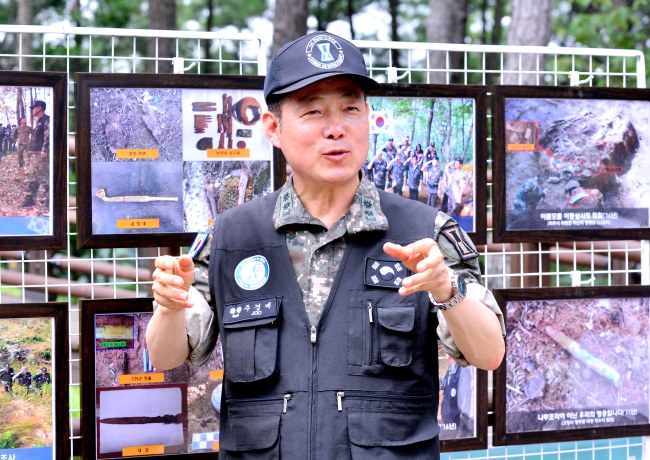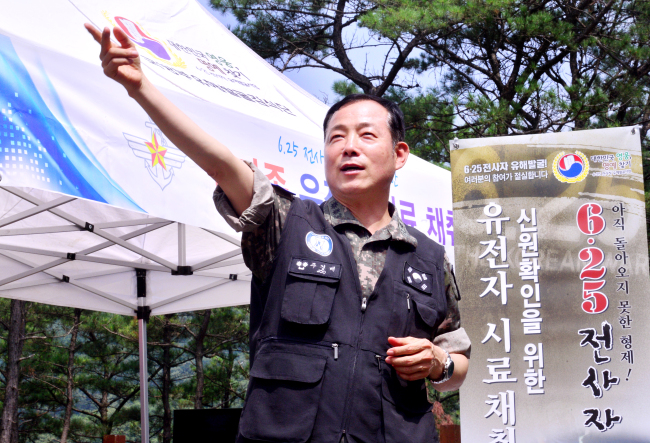PAJU, Gyeonggi Province -- Under the scorching sun at Gamaksan in Paju, Gyeonggi Province, Lt. Col. Ju Gyeong-bae has been standing for hours looking for something unusual in the popular tourist destination famous for having the longest suspension bridge in South Korea.
Wearing battle dress with a black vest, the 51-year-old Army officer looked as if he were trying to sell something. In fact, he was promoting collecting DNA samples from family members who had lost their loved ones during the Korean War.
A 72-year-old man approached Ju with a request to register his DNA on the military’s database. He was hoping to find his father’s remains. His father was killed during the Korean War, when the elderly man was only 3 years old, he said.
“We will get back to you as soon as possible, sir,” said Ju, as he swabbed the old man’s mouth for a DNA sample. “We really appreciate your father’s sacrifice to defending our country and protecting the people.”
 |
Lt. Col. Ju Gyeong-bae promotes the collection of DNA samples to identify those missing during the Korean War at Gamaksan, Gyeonggi Province, Friday. Park Hyun-koo/The Korea Herald |
Ju, chief of the Remain Recovery Branch of the 1st Corps of the Army and an adjunct professor at Seoul Venture University, became, in 2016, the first South Korean military officer to have earned a Ph.D. studying the excavation of war remains.
His job title drew little attention until North Korea’s return of US war remains made global headlines. After months of negotiations, remains believed to be those of 55 US service members were flown out of North Korea on Friday.
The development has thrust into the limelight South Korea’s efforts to recover the war remains of its own fallen soldiers. According to the Ministry of National Defense, about 90,000 war remains are thought to be buried in South Korea and 10,000 in the heavily fortified Demilitarized Zone.
“We were so preoccupied with developing the economy that we didn’t have much time to think about retrieving war remains,” said Ju. “Back in the day, there was no such thing as an excavation project. It was more about picking up the randomly scattered remains.”
It was in 2000, when the country marked the 50th anniversary of the Korean War, that the government launched a nationwide excavation project. Seven years later, a state-run Agency for Killed in Action Recovery & Identification was established under the Defense Ministry.
Ju said recovering war remains often consists of four steps: investigation, excavation, identification and follow-up measures. The recovery agency had excavated 9,684 war remains as of the end of 2017.
The most challenging part of the recovery process is finding the exact location of war remains. Information is limited and most locations have undergone dramatic geographical changes since the Korean War, according to Ju.
“It has been more than 60 years since the war ended, so the places where the soldiers were killed and buried have changed completely,” Ju said. “And there are only a few accounts available from war veterans because most of them passed away.”
“In order to recover one war remain, we need to dig about 300 holes with shovels. ... It’s truly an excruciating process.”
 |
Lt. Col. Ju Gyeong-bae promotes the collection of DNA samples to identify those missing during the Korean War at Gamaksan, Gyeonggi Province, Friday. Park Hyun-koo/The Korea Herald |
The process is complicated because of the lack of equipment to detect remains. According to Ju, as there is no such thing as bone-detection equipment, his team has to dig up the soil meter by meter with shovels.
Identifying recovered war remains is another challenge. The process become much more difficult when remains are of young people without family, because there is little DNA information for cross-reference.
Extracting DNA from the remains buried almost 60 years ago is another issue. In order to pull out accurate DNA information, Agency for Killed in Action Recovery & Identification needs to amplify the bones’ DNA by as much as 1,000 times.
Ju said that is why only a small percentage of recovered war remains have been identified. Among 9,684 recovered South Korean soldiers’ remains, only 128 have been identified by the ministry.
“We are very cautious about identification. For example, even if we find an identification tag from the remains, there is still a chance that the tag might belong to the enemies during the chaotic warfare. So we are very careful until we find compelling evidence,” Ju said.
Given that dozens of forces fought across the Korean War, it is sometimes hard to tell to whether the remains are those of South Korean, American, Chinese, North Korean servicemen or those from UN forces.
Ju noted the identification of allies or enemies often begins with referencing war documents, belongings found alongside the remains and local stories passed on from generation to generation by residents living near battles sites.
When there is no clear evidence, a special committee meeting is held to determine the identification of the remains. If the panel of experts fails to reach a consensus, unidentified remains are deemed South Korean soldiers, Jo added.
“I can’t imagine the surviving families’ frustration if their loved ones were classified as enemies and not buried in the National Cemetery. ... That is why we decided to determine those extremely ambiguous remains to be South Korean soldiers.”
If remains are identified as enemies’, they are either repatriated to their home countries or buried in South Korea. Chinese soldiers’ remains have been returned since 2014, while those from North Korea are buried at an “enemy cemetery” in Paju.
According to Ju, South Korea’s excavation technology is advanced to the point where the country can share its know-how with other countries, particularly those that have suffered armed conflicts similar to the Korean War.
Last year, South Korea signed a memorandum of understanding with Vietnam to enhance cooperation on excavating Vietnam War remains. In 2012, South Korea dispatched an excavation team to Libya to recover the bodies of those who went missing during the civil war.
“Whenever I see the US going all out to find war remains and bring them back home, I am deeply impressed. No matter how long it takes, they are committed to achieving their goal. That’s the message we should deliver to the people.”
Ju added that people who want to register their DNA information or who find anything to report on war remains can contact the remains recovery agency at 1577-5625.
By Yeo Jun-suk(
jasonyeo@heraldcorp.com)







![[Herald Interview] 'Trump will use tariffs as first line of defense for American manufacturing'](http://res.heraldm.com/phpwas/restmb_idxmake.php?idx=644&simg=/content/image/2024/11/26/20241126050017_0.jpg)
![[Health and care] Getting cancer young: Why cancer isn’t just an older person’s battle](http://res.heraldm.com/phpwas/restmb_idxmake.php?idx=644&simg=/content/image/2024/11/26/20241126050043_0.jpg)
